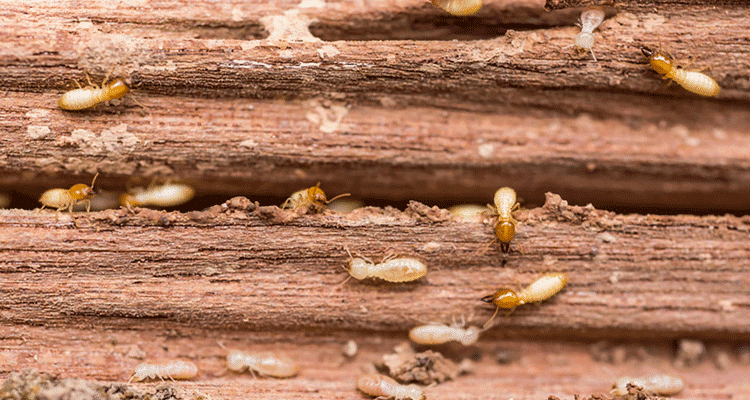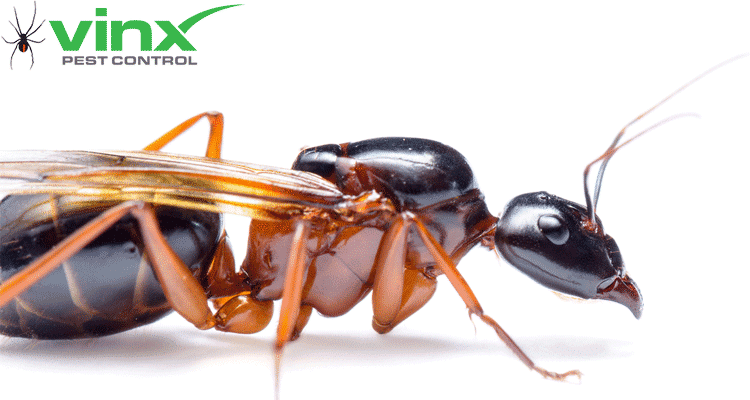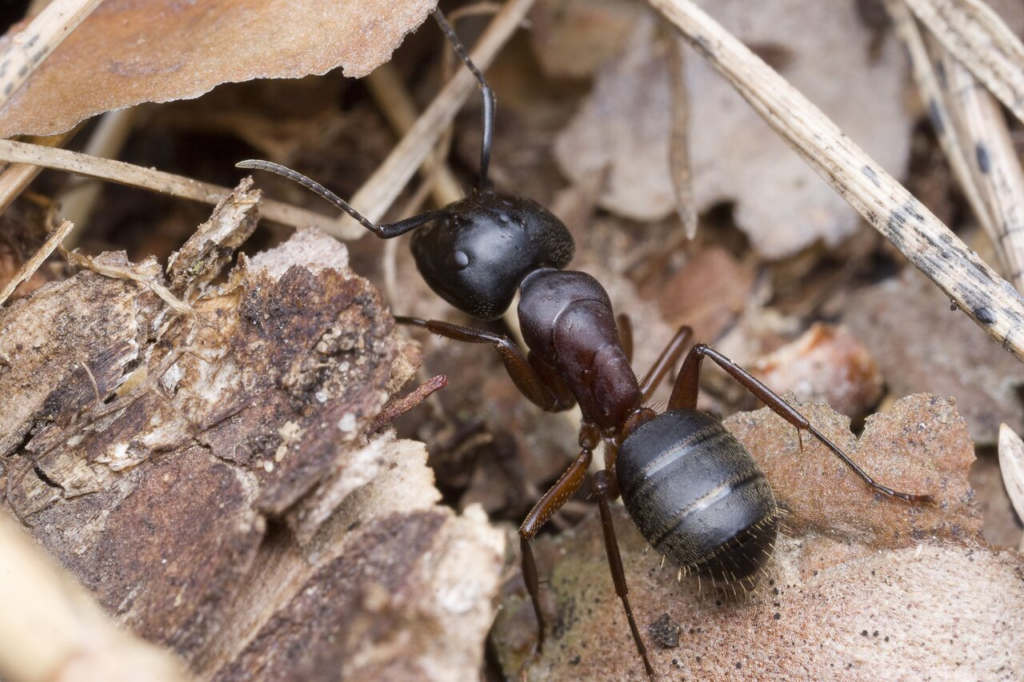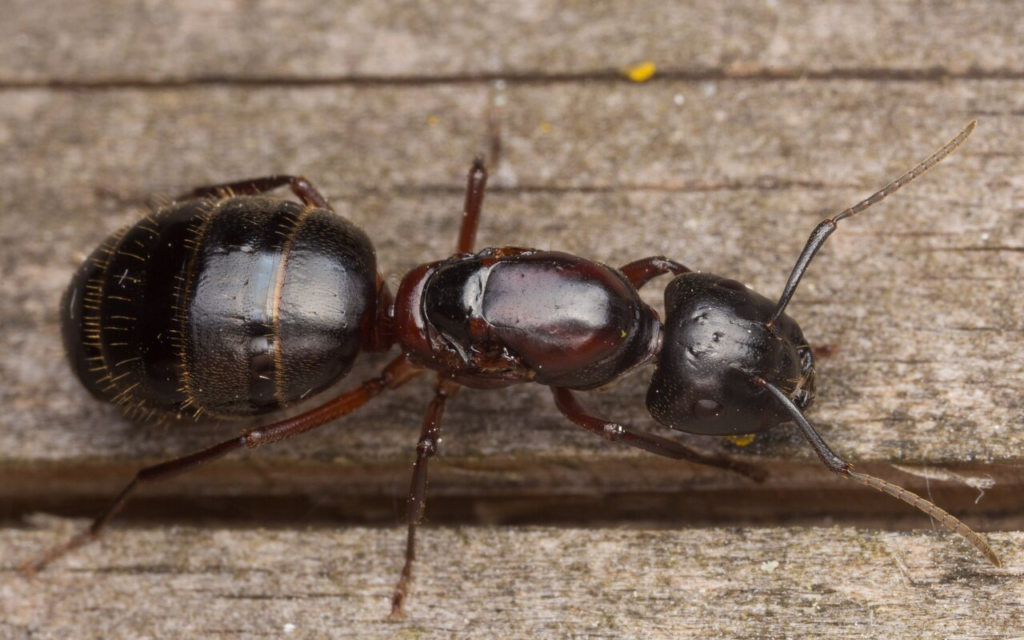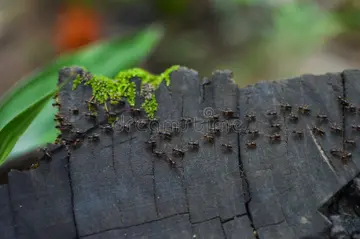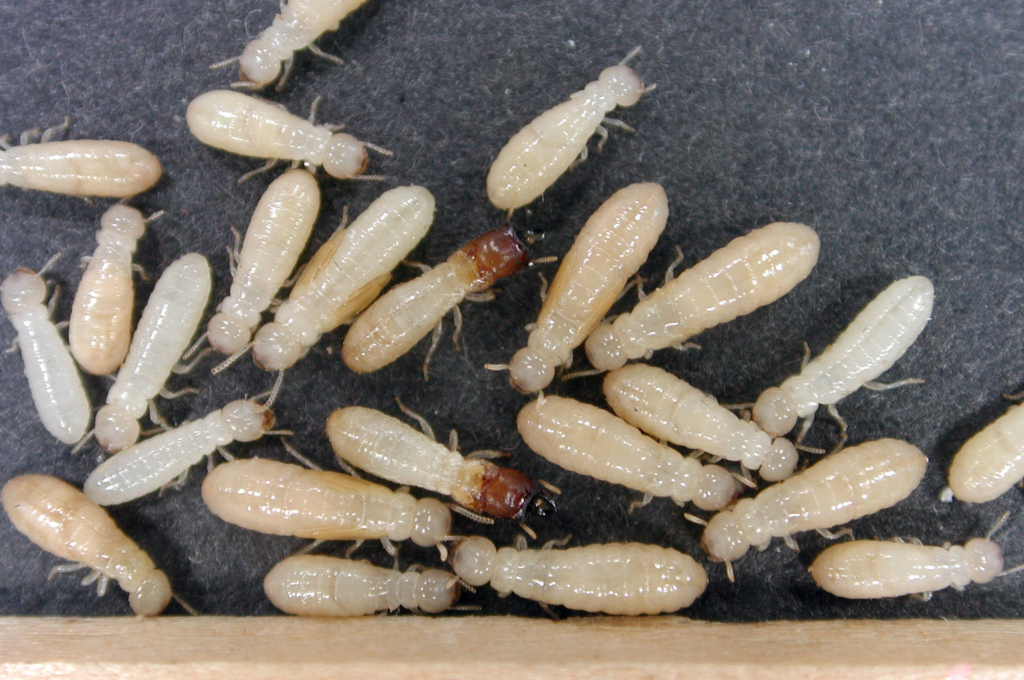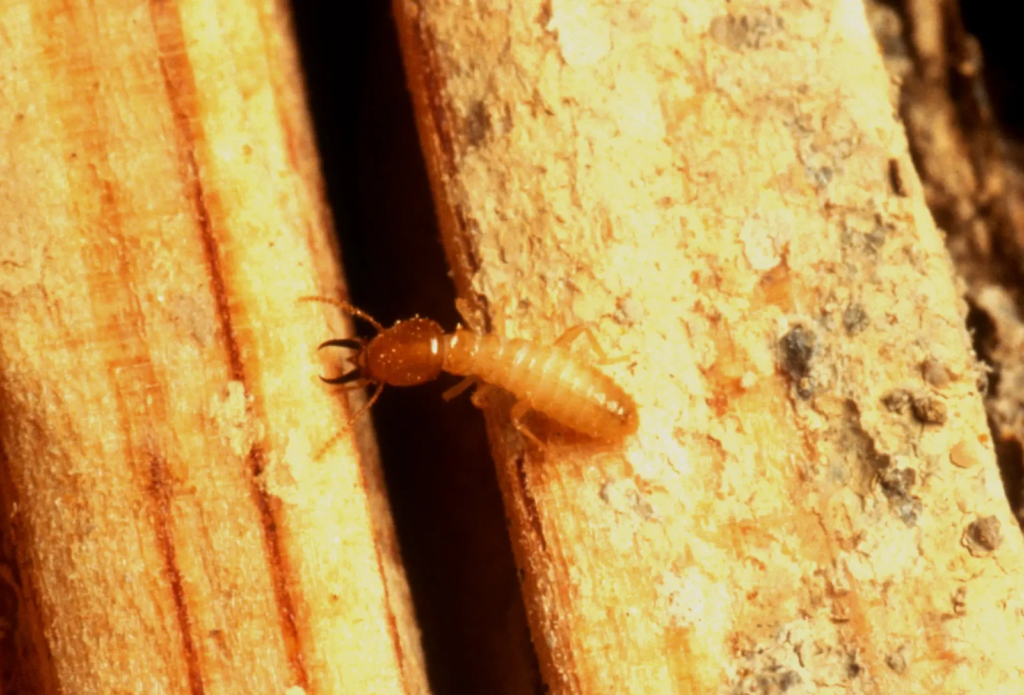Have questions about termites in the Dallas, TX area? We created the ultimate guide to termite treatment and prevention here to help! We’ll answer questions like “what do termites look like,” “how do I get rid of termites,” “do termites bite” and more.
If you have termite problems, we offer several services to help get rid of them! You can get an accurate price quote here.
What Do Termites Look Like?
What do termites look like? In general, termites have no noticeable waist due to thickness through their torso. They also possess antennae that are completely straight and legs that are short in length. Termites come in varieties with and without wings; however, the winged variant of this pest possesses wings that are equal in size in all aspects.
Since termites are similar in appearance to ants, a pest invasion often leaves homeowners puzzled as to what type of nuisance insect has taken up residence in their homes. To complicate the matter, both ants and termites do share a number of similarities, making it difficult to differentiate between the two. For a homeowner to identify a termite and best understand how to treat this persistent pest problem, it is important for them to determine whether they are dealing with termites or ants since treatment methods differ according to species.
How Do I Get Rid of Termites?
Since termites are insidious creatures with the potential to destroy the structural integrity of a home, it is vital that homeowners remove them from their residence as soon as their presence is detected. The only way to permanently eradicate a termite infestation is to determine their nesting locale and exterminate them.
Termite invasions can be very difficult to unearth and often don’t come to light until the damage has already been done to a home. When termite damage reaches this level of destruction, the assistance of a professional pest removal company is often required to eliminate the infestation and prevent further damage. Below is a picture of wood that’s been damaged by termites.
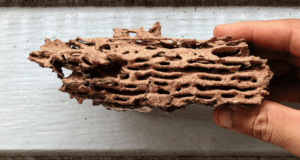
However, homeowners can identify the beginnings of termite colonies and take action before the problem reaches epic proportions.
Here are some steps homeowners can take to get rid of termite colonies:
- Determine the source of the infestation
To ascertain the presence of a termite problem, it is often necessary to do some investigating. More serious infestations are evidenced by floor decay or hollowed out sections of wood or concrete. Barring any signs of this level of structural damage, termite detection will require some extra efforts.
The best course of action is to make use of a flashlight and screwdriver to search wooden foundations and crawlspaces for obvious signs of hollowed out wood. The screwdriver will help determine if the wood has been weakened by termite activity. Should the wood be unstable and prone to breaking, termites are most definitely at work.
Termites will also leave behind waste materials. Termite feces is similar in color to wood but is often darker in hue and shaped like a pellet.
A final indicator is the detection of a termite nesting ground. Infestations of a subterranean nature are evidenced by a network of tunnels comprised of mud. Pest invasions in drywood will be revealed by a constructed nest inside a wooden beam or object.
- Identify the type of termite in the home
The two main types of termites that are the culprits behind infestations are subterranean and drywood termites. Subterranean termites prefer to inhabit dirt regions and wood while drywood termites make their homes in wooden habitats only. Drywood termites have a preferred locale, favoring areas of the country that experience warm temperatures and in states that are nestled along coastal regions. Subterranean termites will thrive in any environment and will inhabit any region.
Though both types of termites are destructive, it is the subterranean variety that causes the most concern. Determining the type of termite affecting a home is critical as extermination methods differ according to the variety of the insect.
- Choose a method of extermination
There are many different home remedies that are reported to eliminate termite infestations. The severity of the problem will determine their efficacy.
Among the treatment options, homeowners can attempt are boric acid sprays of the affected area, cardboard traps, and the use of beneficial nematodes, a type of worm species that gains its nutrition from ingesting termites. Most often, professional pest control services are required to return a home to its former termite-free existence.
- Include preventative measure to avoid future pest invasions
Termites love to flock to environments that are warm and wet. With this in mind, it is key to preventing future termite infestations that a house is kept dry. In addition to this, homeowners can make use of pest repellant sprays to help make a house an inhospitable living environment for termites to discourage an invasion.
Do Termites Fly?
Certain species of termites do possess the ability to fly. The average termite that does not bear wings is extremely light in color. By comparison, flying termites run the gamut of colors with hues ranging from light creams, beiges, and greys to dark brown and even black. The darkest colored termites are the hardiest due to their moisture-preserving qualities, a key component to their survival. Flying termites typically have four wings and measure less than ½” in size.
Most often, the presence of flying termites is an indication of a nearby colony. They are often evidenced by shed wing particles near portals of entry into a home. Flying termites are a very serious concern. Upon detection of a few of these nuisance insects, a thorough inspection of the home and surrounding property is highly recommended as it is likely an active colony is at work.
Do Termites Bite?
Though termites can and do bite humans, they are more interested in feasting on wood and vegetation. Most often, termites resort to biting humans and animals whenever their preferred food source is not readily available. For this reason, termite bites are quite rare.
The Formosan termite is equipped with sharp pincers that are a deeper hue than the remainder of their shell. This type of termite makes use of their pincers as a means of defense against perceived threats. Though the pinches of the Formosan termite are painful, they have no lasting ill effects on the recipient of the pinch.
Do Termites Have Wings?
Termites fall within three different categories with some of the varieties bearing wings and others not. The caste responsible for reproduction both has wings and the ability to fly. This variety is known as a termite swarmer. The other two castes are the soldiers whose primary role is to protect the termite population at large and workers who source for food and continue the work of destroying a home.
Termite swarmers measure between ¼” to 3/8” and are born with two sets of wings that are light grey or smokey-hued in appearance. In size, each wing set is the same. Many people often mistake termites with wings for a winged variety of ant. Upon more careful consideration, it is easy to detect the differences between these two winged creatures. A termite swarmer possesses antennae that are straight and wings of equal proportions. The ant has bent antennae and a front set of wings that are larger than the two located to the rear of the body.
What Do Termites Eat?
Though termite damage is revealed in the wood they select as their favorite snacking material, the nutrition they seek is found in the cellulose contained within the fibers of the wood. Cellulose is abundant in nature and can be found not only in trees and wood products but also in many different types of plants. Termites will even feast on clothing made from cotton and even paper products if given the opportunity.
Cellulose is a critical nutrient in the termite’s diet. These nuisance creatures contain organisms within their digestive tract that effectively render cellulose into nutrition to provide them with necessary energy to continue their work of destroying a home. Because most animals lack the enzymes to properly break down cellulose particles into a viable nutritional substance, cellulose products are most often neglected by other varieties of insects and animals.
The type of termite will determine the insect’s preferred food source. Subterranean termites prefer to feast on springwood due to its soft, fleshy nature. When infested with subterranean termites, consumed wood begins to resemble the shape of a honeycomb. Further investigation will reveal traces of soil and feces within the wood itself.
By comparison, drywood termites favor any type of wood that eschews moisture. This wood is most typically found within a home and is often used to construct framing, structural support beams, hardwood flooring, and even high-quality furniture. This type of termite avoids soil and replenishes the lost moisture in its body via the wood they make their home in. The aftermath wreaked on wood infested with drywood termites remains smooth in appearance.
How Do I Get Rid of Termites in Walls?
Often the most common way to detect termite damage is via hollowed out areas in walls. Since walls provide easy access for termites and they offer considerable space from which a termite can gain nutrition, they are a prime target for hungry termites to devour. Unfortunately, once a termite infestation is evidenced in a wall, professional extermination services are the only means to eradicate the problem.
Termite damage to walls is easy to spot. In its early stages, almost microscopic pinholes will appear throughout the surface of the wall. These little holes may occur in the drywall itself or in wallpaper. Alternatively, lines may appear in the wall itself. These faintly glimpsed lines are often indicative of tunneling which is taking place beneath the drywall.
Other indications a wall is affected by termite damage include:
- A hollow response to tapping
- Paint that appears bubbled
- Paint that is peeling
- Weakened baseboards
- Doors or windows that resist opening
Though both drywood and subterranean termites bear culpability for damage to walls in homes, it is most often subterranean termites that are to blame for this type of destruction. When this variety of termite is at work, walls and even ceilings can take on the appearance of damage from a water-related issue. If there is any evidence of weakened wooden beams, drywall that is changing color, or paint that is bubbling along the surface, termite damage is likely.
Drywood termites prefer to inhabit studded walls and wooden furniture. Smaller in colony size, drywood termites take far longer to accomplish their work. The preferred mode of destruction for this class of insect is to consume wood beginning on the inside and gradually working outwards. Any wood that sounds hollow when rapped upon is likely home to a colony of hungry termites.
What Kills Termites?
Though professional pest control services are often required to eliminate a termite infestation, there are several alternative treatments that homeowners can attempt on their own.
Here are four popular DIY termite treatment protocols to consider:
- Apply a pesticide barrier
Pesticide barriers come in liquid form and are intended for use as a spray to kill existing termite colonies and provide preventative measures against future infestations. This type of pest control treatment is reported to kill termites directly upon contact. Most often, the pesticide is implemented around the perimeter of a house, but it is also safe for use around wooden items such as tree stumps, wooden furniture, or piles of wood.
Most pesticides are not detectable by termites, meaning they are a highly effective mode of treatment. The poison in the pesticide moves at a slow rate, ensuring termites spread the toxins to other members of the colony to encourage a rapid elimination of the infestation.
- Setting poisoned bait traps
Many people worry that the application of a liquid pesticide barrier may be harmful to their family members or pets and prefer to use something a little less harsh. Poisoned bait traps pinpoint specific areas within a home or yard, and thus, less of the toxic material is needed to achieve the desired result. Entire colonies are often eliminated in as little as one treatment. However, rain and moist weather conditions can result in false termite elimination responses on the traps. In addition to this, poisoned bait traps are limited to use with drywood termites.
- Treat with boric acid
Boric acid is extremely caustic yet is still considered a safe treatment method for eliminating termite invasions. Boric acid is an effective pest control protocol for most nuisance insects including termites. It is believed that the acid itself wreaks negative impacts on the termite’s ability to digest and metabolize food sources. Within three to seven days of contact with boric acid, termites succumb to death.
Boric acid is not considered to be a natural remedy; however, it is far less harmful to human beings and their pets than traditional pesticides. Boric acid can also be purchased in a powder under the brand name Borax and is available at most grocery and hardware stores.
- Sprinkle some diatomaceous earth
Diatomaceous earth is a safe, non-toxic termite treatment. Comprised largely of tiny fossilized aquatic skeletons, this silica substance is found at the bottom of many bodies of water including lakes, rivers, and oceans. The razor-sharp bone particles found in diatomaceous earth tear into the outer shells of termites, leeching moisture from their bodies and exposing them to dehydration which ultimately claims their lives.
Have a termite problem in Dallas, Fort Worth, or the surrounding area and wish you didn’t? Try one of our home remedies or contact us at 972-855-8469 to make your termite problems go away!



